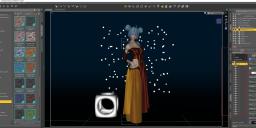Importing OBJ and then saving the surface texture preset to be reused
 Ruris
Posts: 123
Ruris
Posts: 123
Hi all,
Currently this is my workflow:
a) create clothing items in Marvelous Designer
b) Export as OBJ
c) Import in Daz3d (no conforming, nothing, just plain OBJ as its posed in MD)
d) Apply shader preset to OBJ item. Highlight surface > specific parts > Apply shader.
e) How do I save the surface preset, the whole dress as one 'singular file' ? File > Save as > Shader Preset > this can only works for specific Dress parts it seem.


Forum 10.jpg
2542 x 1132 - 913K


Comments
Use a material preset, not shader preset.
Thanks leana!
(darn, the option was just below but I missed it)
Just be careful about saving the .obj uvs in a Material preset. Quite often, DS wants to look for the original data file with the uvs and throws an error when it can't find it. If you expand a material in the Save dialog, then uncheck 'UV Maps' this won't happen. DS treats the saved preset as neutral.
It's a mystery to me why this option is checked by default, although most times it isn't really an issue. However, I mention it because last night I saved a bunch of material presets from a prop, then deleted the data folder, imported a new version of the prop, saved it as an asset, and tested the presets - all of which threw a 'Can't find the UVs' error. I'm not even sure why it only happens occasionally, but if you're selling/re-distributing anything, it could cause problems.
Hi maclean,
Thanks for sharing. Do you know what kind of keyword should I be searching for, to checkout how to 'pack an object with texture'? Not really for commercial purpose, just for own storage.
This is my situation right now:
a) created dress in MD
b) Import dress into DAZ
c) lazily click on commercial shader on each part of the OBJ dress and save as material preset when done
d) however, I know that, the texture on the OBJ is just a 'link' to the original shader and if the original shader is moved to another folder etc, then i will lose everything.
e) is there any universal solution where the OBJ and the material can be combined?
Can't you just save as > Figure /Prop asset. This saves the obj + its surfaces. That's how i save static prop Objs.
It will still need links to the textures used on surfaces to be maintained. To maintain links to texture files, keep all your textures in a locaiton on your drive that you will never move. Material presets are only really valuable if you have multiple varieties of materials for the prop in my opinion.
Side note: Marvelous Designer will change Surface/Material Zone names of Obj with each export (it appends a different number onto the end of the fabric group name, doesnt it?) therefore a material preset wont be applicable to a newly exported Obj that was exported from MD anew.
EDIT: Actually, I see from your screenshot that you have exported your garment in a different way than the typical way (see April's instructions in the MD thread for what i mean by the typical way), so maybe your method will conserve the surface names upon export. Your way looks like it is giving a material zone/surface name to each pattern piece rather than appending a unique number on the end of the fabric group names.
Yeah, saving the .obj as an asset is the safest way. But of course, if you have multiple items, you'll end up with lots of files. The Asset dialog dropdown menus allow you to save to any existing folder in data, or create a new one, with a product name, so you can throw them all into 1 data folder and know where they are if you ever want to get rid of them.